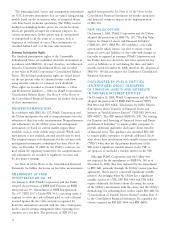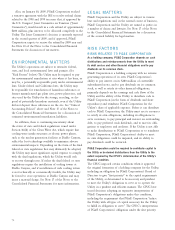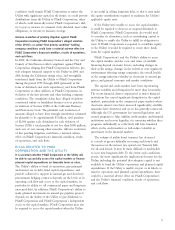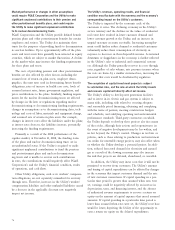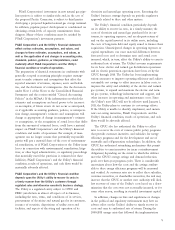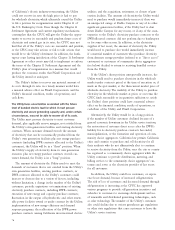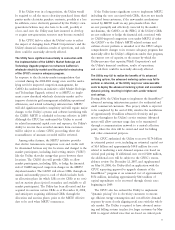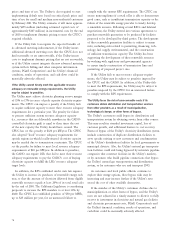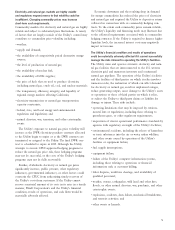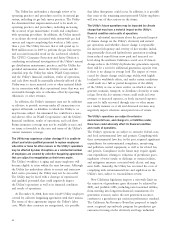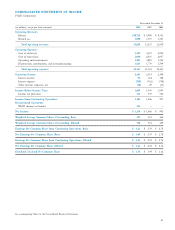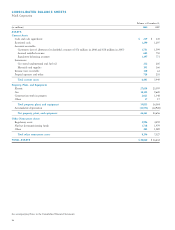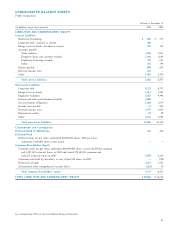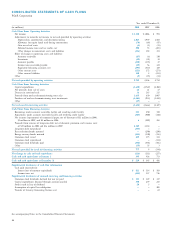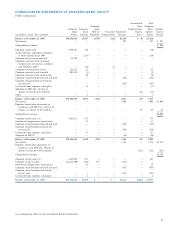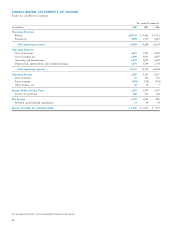PG&E 2008 Annual Report Download - page 80
Download and view the complete annual report
Please find page 80 of the 2008 PG&E annual report below. You can navigate through the pages in the report by either clicking on the pages listed below, or by using the keyword search tool below to find specific information within the annual report.78
comply with the current RPS requirements. The CPUC can
excuse noncompliance if a retail seller is able to demonstrate
good cause, such as insuffi cient transmission capacity or the
failure of the renewable energy provider to timely develop
a renewable resource. Following several RFOs and bilateral
negotiations, the Utility entered into various agreements to
purchase renewable generation to be produced by facilities
proposed to be developed by third parties. The development
of these renewable generation facilities is subject to many
risks, including risks related to permitting, fi nancing, tech-
nology, fuel supply, environmental, and the construction
of suffi cient transmission capacity. The Utility has been
supporting the development of these renewable resources
by working with regulatory and governmental agencies
to ensure timely construction of transmission lines and
permitting of proposed project sites.
If the Utility fails to meet resource adequacy require-
ments, the Utility may be subject to penalties imposed by
the CPUC and the CAISO. In addition, if the Utility fails
to meet the RPS requirements, the Utility may be subject to
penalties imposed by the CPUC for an unexcused failure
to comply with the RPS requirements.
The Utility faces the risk of unrecoverable costs if its
customers obtain distribution and transportation services
from other providers as a result of municipalization,
technological change, or other forms of bypass.
The Utility’s customers could bypass its distribution and
transportation system by obtaining service from other sources.
This may result in stranded investment capital, loss of
customer growth, and additional barriers to cost recovery.
Forms of bypass of the Utility’s electricity distribution system
include construction of duplicate distribution facilities to
serve specifi c existing or new customers and condemnation
of the Utility’s distribution facilities by local governments or
municipal districts. Also, the Utility’s natural gas transporta-
tion facilities could risk being bypassed by interstate pipeline
companies that construct facilities in the Utility’s markets,
or by customers who build pipeline connections that bypass
the Utility’s natural gas transportation and distribution
system, or by customers who use and transport LNG.
As customers and local public offi cials continue to
explore their energy options, these bypass risks may be
increasing and may increase further if the Utility’s rates
exceed the cost of other available alternatives.
If the number of the Utility’s customers declines due to
municipalization or other forms of bypass, and the Utility’s
rates are not adjusted in a timely manner to allow it to fully
recover its investment in electricity and natural gas facilities
and electricity procurement costs, PG&E Corporation’s and
the Utility’s fi nancial condition, results of operations, and
cash fl ows could be materially adversely affected.
prices and time of use. The Utility is also required to start
implementing default rates based on critical peak prices and
time of use for small and medium non-residential customers
by February 2011. The Utility estimates it will incur approxi-
mately $155 million (including estimated capital costs of
approximately $107 million) in incremental costs by the end
of 2010 to implement dynamic pricing to meet the CPUC’s
required schedule.
If the Utility fails to recognize the expected benefi ts of
its advanced metering infrastructure, if the Utility incurs
additional advanced metering costs that the CPUC does not
fi nd reasonable or are unrecoverable, if the Utility incurs
costs to implement dynamic pricing that are not recoverable,
or if the Utility cannot integrate the new advanced metering
system with its billing and other computer information
systems, PG&E Corporation’s and the Utility’s fi nancial
condition, results of operations, and cash fl ows could be
materially adversely affected.
If the Utility cannot timely meet the applicable resource
adequacy or renewable energy requirements, the Utility
may be subject to penalties.
The Utility must achieve electricity planning reserve margin
of 15% to 17% in excess of peak capacity electricity require-
ments. The CPUC can impose a penalty if the Utility fails
to acquire suffi cient capacity to meet these resource adequacy
requirements for a particular year. The penalty for failure
to procure suffi cient system resource adequacy capacity
(i.e., resources that are deliverable anywhere in the CAISO-
controlled electricity grid) is equal to three times the cost
of the new capacity the Utility should have secured. The
CPUC has set this penalty at $120 per kW-year. The CPUC
also adopted “local” resource adequacy requirements for
specifi c regions in which locally-situated electricity capacity
may be needed due to transmission constraints. The CPUC
set the penalty for failure to meet local resource adequacy
requirements at $40 per kW-year. In addition to penalties,
the CAISO can require LSEs that fail to meet their resource
adequacy requirements to pay the CAISO’s cost of buying
electricity capacity to fulfi ll the LSEs’ resource adequacy
target levels.
In addition, the RPS established under state law requires
the Utility to increase its purchases of renewable energy each
year, so that the amount of electricity delivered from eligible
renewable resources equals at least 20% of its total retail sales
by the end of 2010. The California Legislature is considering
proposals to increase the RPS mandate to at least 33% by
2020. The CPUC has established penalties of $50 per MWh,
up to $25 million per year, for an unexcused failure to




